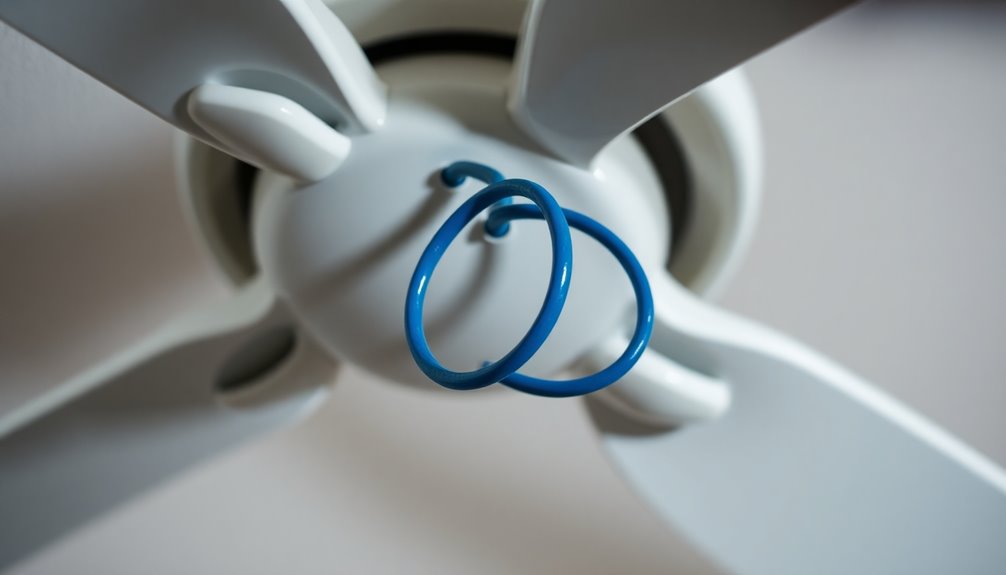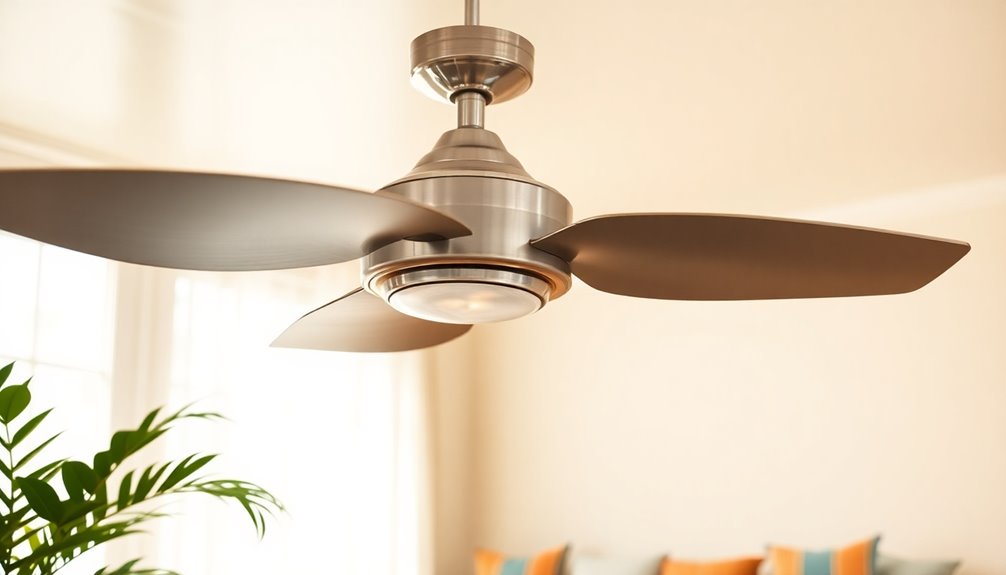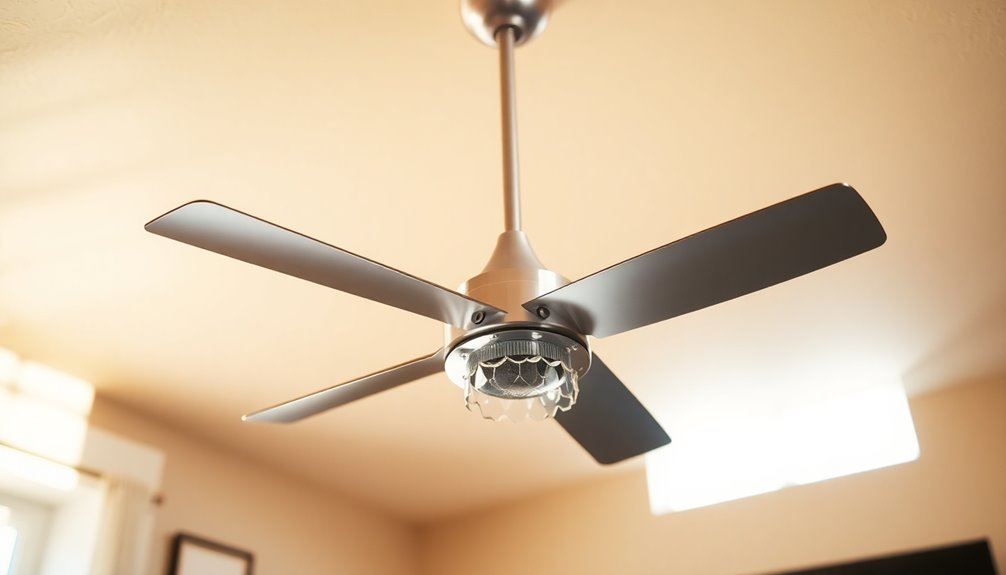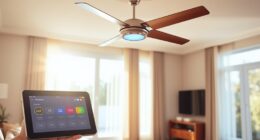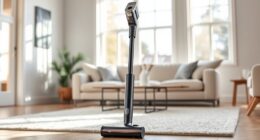Running a ceiling fan in winter can save you money by redistributing warm air throughout your home. When you set the fan to spin clockwise, it creates an updraft that pushes warm air back down, reducing cold spots and making your space feel cozier. This simple adjustment can allow you to lower your thermostat by up to 4 degrees, potentially cutting heating costs by 15%. Just remember to use a low-speed setting to avoid drafts. If you want to know more about how to maximize energy savings with your ceiling fan, there are plenty of helpful tips available.
Key Takeaways
- Running a ceiling fan in winter helps redistribute warm air, enhancing comfort and reducing cold spots in rooms.
- Clockwise rotation can lower thermostat settings by up to 4 degrees, leading to potential energy savings.
- Using fans can save up to 15% on heating costs by decreasing reliance on the heating system.
- ENERGY STAR-rated fans consume 60% less energy, contributing to overall energy savings during winter.
- Regular maintenance and low-speed operation of fans optimize performance without creating uncomfortable drafts.
How Ceiling Fans Contribute to Heating

When it comes to comfort during the winter months, the effectiveness of ceiling fans often goes unnoticed.
You mightn't think of your ceiling fan as a winter ally, but it plays a significant role in heating your home. By setting your ceiling fan to rotate in a clockwise direction, you can create an updraft that pushes warm air, which naturally rises, back down into the living space.
This simple adjustment helps distribute heat evenly throughout the room, eliminating cold spots and enhancing your overall comfort.
Benefits of Clockwise Rotation

Setting your ceiling fan to rotate clockwise offers several benefits that enhance your winter comfort. When you switch the fan's direction, it creates an updraft that pushes warm air down from the ceiling. This helps redistribute the warm air throughout the room, maintaining a more consistent temperature and eliminating cold spots.
By promoting air movement in this direction, you can potentially lower your thermostat settings by up to 4 degrees. This adjustment means you won't rely as heavily on your heating system, allowing you to save money on energy bills.
Utilizing a ceiling fan in the winter can lead to savings of up to 15% on heating costs, making it a smart choice for homeowners. Additionally, using the ideal low-speed setting maximizes warmth without creating uncomfortable drafts, making your indoor environment cozier.
The combination of warm air circulation and energy efficiency makes clockwise rotation an effective strategy during winter months. So, if you want to enhance your comfort while saving on heating costs, be sure to set your ceiling fan to rotate clockwise. Your winter experience will be warmer and more enjoyable, all while keeping your energy bills in check.
Energy Savings From Ceiling Fans

Ceiling fans can be a game-changer for your energy savings during the winter months. When you run ceiling fans in winter mode, they redistribute the warmer air that gathers near the ceiling, helping you save energy and lower your energy bills. By allowing your thermostat to drop by about 4 degrees, you can cut heating costs by up to 15%. Additionally, many ceiling fans are designed to be compatible with smart home devices, providing an extra layer of convenience and efficiency.
Here's how ceiling fans work for energy savings:
| Benefit | Description |
|---|---|
| Warmer Air Redistribution | Fans push down warm air, enhancing air distribution. |
| Lower Heating Bills | Reducing thermostat settings leads to lower bills. |
| Enhanced Heating Performance | Fans make your furnace work less, extending its life. |
| ENERGY STAR Efficiency | ENERGY STAR-rated fans use 60% less energy than standard models. |
| Elimination of Cold Spots | Improved circulation creates a uniformly comfortable environment. |
Additionally, using ceiling fans in conjunction with heat pump systems can further maximize your home's energy efficiency during colder months. This combination of energy-efficient technology ensures that you maintain a comfortable environment while optimizing your heating performance. By integrating commercial grade heat pumps, you can achieve even greater energy savings and enhance overall comfort in your living space. Proper fire safety measures should also be considered when using heating devices in winter to ensure a safe environment.
Common Misconceptions About Usage

Many homeowners hold misconceptions about using ceiling fans in winter, which can lead to ineffective heating strategies. Understanding how to use your ceiling fan can make a significant difference in energy savings and comfort levels.
Here are some common myths:
- Ceiling fans cool the room: In winter, the ceiling fan spin should be reversed to push warmer air down, not to cool the room.
- Fans generate heat: Ceiling fans don't create heat; they help circulate existing warm air, aiding air distribution throughout the space. This circulation can complement the benefits of using an air purifier to improve overall indoor air quality, especially as proper airflow enhances performance. Additionally, proper air circulation can help reduce energy consumption during the winter months.
- Leaving fans on in empty rooms saves energy: If no one's there, running the fan won't provide benefits and can waste electricity.
- Any speed works for winter: Operating your fan at a low setting minimizes uncomfortable drafts while still moving air and redistributing warmth effectively. Additionally, using a geothermal heat pump can enhance overall energy efficiency, contributing to lower utility bills during winter months.
To optimize your ceiling fan's performance, verify you have a switch that allows for winter-mode fan operation. This can lead to a warmer environment during those chilly months while enhancing comfort and lowering energy bills.
Tips for Optimal Fan Operation

To get the most out of your ceiling fan during winter, it's important to know how to operate it effectively. First, use your ceiling fan's switch to change the direction of the blades to clockwise. This simple adjustment allows the fan to push warm air down from the ceiling, enhancing the distribution of heat throughout the room.
Running your fan on a low speed can create a warmer environment, making it easier to maintain comfort as temperatures drop. By keeping warm air circulating near your thermostat, you can lower the thermostat setting, which helps save on heating costs.
In fact, running your fan in the cold winter months can save you up to 15% on your heating bills. Regular maintenance is key to peak performance. Clean the blades and check that everything operates smoothly to guarantee your fan works efficiently.
With these tips, you'll maximize your ceiling fan's benefits during winter, making your home cozier while cutting down on energy consumption. So, don't overlook your fans this winter; they can be a critical component in staying warm and saving money.
Frequently Asked Questions
How Much Does a Ceiling Fan Help in the Winter?
A ceiling fan can really help in the winter by redistributing warm air that rises to the ceiling.
When you set it to rotate clockwise at a low speed, it creates an updraft that pushes that warm air back down, making your space more comfortable.
This can eliminate cold spots and lead to a more even temperature throughout your home.
Plus, you can lower your thermostat settings a bit without sacrificing warmth.
Is It Expensive to Leave Ceiling Fans on All the Time?
Imagine walking into a room and feeling a breeze, but there's no one there. You might think it's invigorating, but leaving ceiling fans on all the time can be expensive.
While they use low energy, running them continuously adds up, especially in unoccupied spaces. If you're not optimizing their use, like adjusting speeds or turning them off when you leave, you're likely wasting money rather than saving it.
Be strategic to truly benefit.
Should You Run a Ceiling Fan in the Winter Time?
You should definitely consider running a ceiling fan in the winter.
When set to rotate clockwise, it creates an updraft that pushes warm air down, making your space cozier. Keeping the fan on a low speed prevents any uncomfortable drafts while circulating the warmth effectively.
This simple adjustment can enhance your comfort level, allowing you to enjoy a warmer room without cranking up the thermostat.
It's a smart way to optimize your heating!
Do Ceiling Fans Raise the Electric Bill?
Yes, ceiling fans can raise your electric bill, but the increase is usually minimal.
Most fans use between 30 to 100 watts, which is considerably less than heating systems. If you run your fan for a few hours, you might only see an increase of about $0.50 to $1.00 monthly.
However, the energy efficiency gained from better air circulation can often outweigh this small increase, helping you save in the long run.
Conclusion
So, next time winter rolls around, don't overlook your ceiling fan. By simply switching it to clockwise, you can push warm air down and save on heating costs. It's a small adjustment that can lead to noticeable savings, almost like finding extra cash in your pocket! Embrace this easy tip and enjoy a cozier home while keeping your energy bills in check. Who knew a ceiling fan could be your winter ally?

